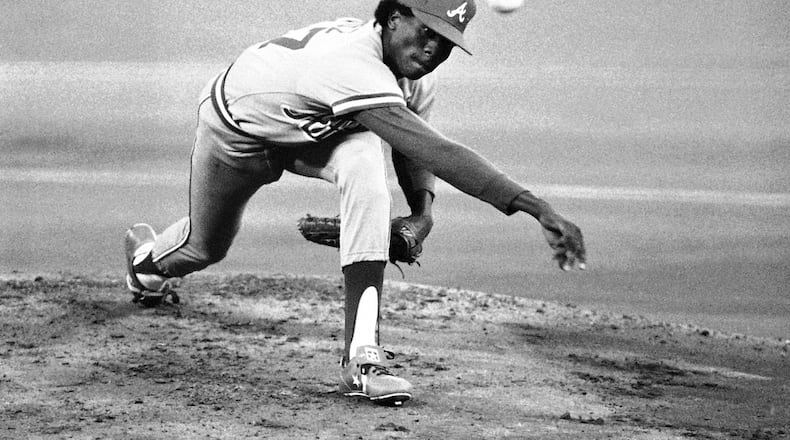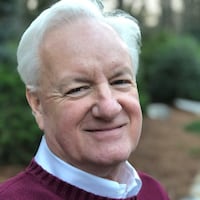Editor’s note: At a time when sports are shut down, including the canceled Final Four in Atlanta and many other postponed events, we take a look (in no particular order) at some of the bizarre moments from Georgia sports history.
For those of us in the Atlanta-Fulton County Stadium press box on the night of Aug. 19, 1982, the first sign that something was amiss came when Phil Niekro headed to the bullpen to warm up.
Pascual Perez was supposed to be the starting pitcher for the Braves that night. So why was Niekro, the staff ace, warming up? Was Perez injured? Or ill? Or were the Braves so desperate for a win, having lost 19 of their past 21 games, that they decided at the last minute to start their Hall of Fame-bound knuckleballer on short rest?
The explanation wasn’t nearly so mundane.
In what remains, almost four decades later, one of the more bizarre tales in Atlanta sports history, Perez was scratched for a reason perhaps unique in major-league annals: He couldn’t find the ballpark.
The 25-year-old right-hander from the Dominican Republic was new to Atlanta and its highways. He had gotten his Georgia driver’s license earlier that day. He had the music turned up loud on the car radio.
Someone had told him to take I-85 from his apartment to the stadium, but he got on I-285 instead. He thought, in those long-before-GPS days, that he’d see a highway exit sign directing him to the ballpark. And he would have — if he’d been on the right road.
On what should have been less than a 20-minute trip, he drove for more than three hours, almost 2-1/2 times around the Perimeter, going almost 150 miles in circles around the city, before eventually realizing he was running out of gas and time.
He stopped a few places to ask for directions. He was told at one point to find I-20, but couldn’t. He wound up at a service station and asked for $10 worth of gas, even though he had forgotten his wallet. The clerk, who apparently had been listening to the Braves’ pregame radio show, recognized and accommodated the pitcher.
“The guy say, ‘You Pascual Perez? People been waiting for you at the stadium,’ ” Perez recalled in a 1989 Sports Illustrated interview. “I’m 20 minutes away, he tell me. I feel like a heart attack. I think I get fired, maybe.”
Perez finally arrived at the ballpark “just as they were playing the national anthem,” he told reporters after the game. “When I finally saw the stadium, I said, ‘Thank the Lord.’ ”
Perez watched most of the game from the clubhouse and the dugout as Niekro, who had been told about 30 minutes before game time that he would start, pitched in his place.
Credit: Beverly Crawford
Credit: Beverly Crawford
The whole ludicrous incident seemed to immediately resonate with the city for a couple of reasons. For one thing, even then, most Atlantans spent way more time than they would like on I-285 (or some other highway). And for another thing, a pitcher getting lost on the way to the ballpark seemed an endearingly Braves-like occurrence, in keeping with the travails of an organization that had suffered six losing seasons in the previous seven years.
By the end of the game on Aug. 19, 1982, a Thursday, everyone was laughing about Perez’s plight. Some of his teammates hung maps of the city on his locker.
Maybe the reaction would have been less forgiving if the Braves had lost the game. But they got a much-needed win, beating the Montreal Expos 5-4 to break a four-game losing streak. Niekro pitched seven innings for the win.
The laughter proved therapeutic for a team that until that night seemed to be buckling under the stress of a pennant race.
The Braves had opened the 1982 season with a mind-boggling 13 consecutive wins, and they led the National League West by nine games in late July. But then they hit hard times, falling into a tailspin that had reached 19 losses in 21 games by the time Perez got on I-285. By then, the Braves were four games behind the surging Dodgers in the NL West.
(Speaking of a bad sense of direction: What in the world were the Atlanta Braves doing in the Western Division from 1969 through 1993?)
Anyway, starting with Perez’s tour of the Perimeter, the Braves won six games in a row and 13 of the next 15 to retake the division lead. Their manager, Joe Torre, traced the turnaround to one thing.
“It was Pascual Perez getting lost,” Torre said in an interview with this reporter, published in this newspaper on Aug. 29, 1982. “That lightened the mood. That made the players laugh and relax. And that turned us back around. I really believe that.”
The division race went down to the final day of the regular season, but the Braves won it to reach the playoffs for the first time since 1969. Perez won two games in the final week of the season. By then, fans had bestowed several affectionate nicknames on him: “Perimeter Perez,” “Perimeter Pascual” and “I-285.”
Perez embraced the attention. He wore a warm-up jacket with “I-285” on the back. At a 1983 game, the Braves gave “Perez-style” maps of I-285 to the first 14,000 fans to enter the gates. Almost four decades later, Braves fans still cherish the time a pitcher couldn’t find the ballpark.
On the day he got lost, Pascual Perez found his spot in Braves history.
Less than two months before the commute that made him famous, the Braves acquired Perez and a player to be named later from the Pirates for pitcher Larry McWilliams. The Braves initially sent Perez to their Triple-A team in Richmond, Va., where he pitched extremely well, and then promoted him to the big leagues during a late-July 1982 homestand. He pitched in a couple of games at home before the Braves went on an 11-day trip to the West Coast.
The start he missed was on the fourth day of the Braves’ next homestand. He was still learning his way around the ballpark, not to mention the city.
He finished the 1982 season with a 4-4 record and a 3.06 ERA, and he was with the Braves through the next three seasons. He won 15 games and made the All-Star team in 1983 and won 14 games in 1984. But he had an awful season in 1985, going AWOL from the team at one point en route to a 1-13 record and 6.14 ERA. The Braves released him at the end of spring training in 1986.
Perez returned to the major leagues with Montreal in 1987 and last pitched for the Yankees in 1991, finishing with a career record of 67-68 and a 3.44 ERA. He made 193 big-league stats, none of them gaining as much attention as the start he missed.
Perez died at age 55 on Nov. 1, 2012, killed during an apparent robbery attempt at his Dominican Republic home.
Back in the summer of 1982, Perez showed up at Atlanta-Fulton County Stadium on time the day after his I-285 odyssey. He started the Aug. 20, 1982, game against the Mets and allowed just one run in 9-2/3 innings of work. He told reporters afterward that this time he used a map, got on I-85 (“not I-285”) and reached the ballpark in about 15 minutes.
“I know the way now,” he said.
About the Author
Keep Reading
The Latest
Featured




